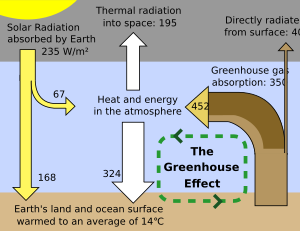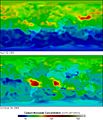Greenhouse gas facts for kids

A greenhouse gas is a type of gas that traps heat in Earth's atmosphere. Think of it like a blanket around our planet. These gases stop heat from escaping into space. This process makes Earth warmer than it would be otherwise. This warming effect is known as the "greenhouse effect".
Most greenhouse gases are found naturally. Water vapor is the most common natural greenhouse gas. It causes a large part of Earth's natural greenhouse effect. Other natural greenhouse gases include carbon dioxide, methane, nitrous oxide, and ozone.
Without these gases, Earth would be too cold for life to exist. The heat they trap is important for plants, animals, and humans. Natural amounts of greenhouse gases can change over time. For example, huge volcanic eruptions long ago might have released many gases. This could have caused big changes in Earth's climate.
Contents
How Humans Affect Greenhouse Gases
Humans are adding more greenhouse gases to the atmosphere. This is making the planet's average temperature rise. The most important gas that humans add is carbon dioxide. It now makes up about 0.04% of the atmosphere.
Burning Fossil Fuels
Carbon dioxide is released when people burn fossil fuels. These fuels include oil, coal, and natural gas. We burn them mostly to create heat and electricity. This happens in power plants and factories. Cars, trucks, and planes also burn fossil fuels for transport.
Farming and Deforestation
Farming also adds greenhouse gases. For example, raising cattle and other farm animals like pigs and chickens releases methane. Scientists have found that producing just 1 kilogram of beef creates more carbon dioxide than a three-hour car ride.
Humans also reduce Earth's ability to absorb carbon dioxide. This happens when we cut down trees. Trees naturally take carbon dioxide out of the air. Fewer trees mean more carbon dioxide stays in the atmosphere.
Water Vapor and Warming
Water vapor is the most common greenhouse gas. It reacts to climate change. When the atmosphere gets warmer, there is more water vapor. This can lead to more clouds and rain. Human activities also add water vapor. This can happen from cooling towers at power plants. Creating artificial lakes can also increase evaporation. All these actions contribute to global warming.
Images for kids
-
Schmidt et al. (2010) analyzed how individual components of the atmosphere contribute to the total greenhouse effect. They estimated that water vapor accounts for about 50% of Earth's greenhouse effect, with clouds contributing 25%, carbon dioxide 20%, and the minor greenhouse gases and aerosols accounting for the remaining 5%. In the study, the reference model atmosphere is for 1980 conditions. Image credit: NASA.
-
Top: Increasing atmospheric carbon dioxide levels as measured in the atmosphere and reflected in ice cores. Bottom: The amount of net carbon increase in the atmosphere, compared to carbon emissions from burning fossil fuel.
See also
 In Spanish: Gas de efecto invernadero para niños
In Spanish: Gas de efecto invernadero para niños








